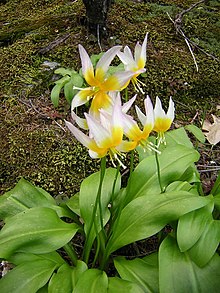Erythronium taylorii is a rare species of flowering plant in the lily family known by the common names Pilot Ridge fawn lily, Taylor's fawnlily, and Yosemite fawn lily. It is endemic to Tuolumne County, California, where it is known only from Pilot Ridge, a remote mountain ridge outside of Yosemite National Park. It was discovered in 1996 and described to science as E. taylori in 1997, and it is now called E. taylorii.[2] There are at least 1000 individuals in the single known population.[1] It occurs on shaded north-facing cliffs.
| Erythronium taylorii | |
|---|---|

| |
| Scientific classification | |
| Kingdom: | Plantae |
| Clade: | Tracheophytes |
| Clade: | Angiosperms |
| Clade: | Monocots |
| Order: | Liliales |
| Family: | Liliaceae |
| Subfamily: | Lilioideae |
| Tribe: | Lilieae |
| Genus: | Erythronium |
| Species: | E. taylorii
|
| Binomial name | |
| Erythronium taylorii | |
This lily grows from a bulb several centimeters wide and produces wavy-edged basal leaves up to 35 centimeters long. The green flowering stem is up to 40 centimeters tall and bears 1 to 8 showy, pendent lily flowers. Each flower has six lance-shaped tepals which may be over 4 centimeters long. They are white with bright yellow bases and fade pink with age. The six long yellow stamens are tipped with large white anthers.
References
edit- ^ a b "The Nature Conservancy". Archived from the original on 2013-04-15. Retrieved 2010-12-21.
- ^ Shevock, J.R.; Allen, G.A. (October 1997). "Erythronium taylori (Liliaceae), a New Species from the Central Sierra Nevada of California". Madroño. 44 (4). Berkeley: California Botanical Society: 359–363. eISSN 1943-6297. ISSN 0024-9637. JSTOR 41425225 – via Biodiversity Heritage Library.
External links
edit
